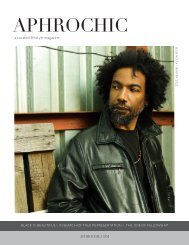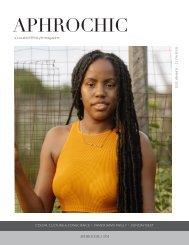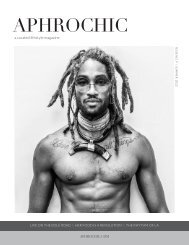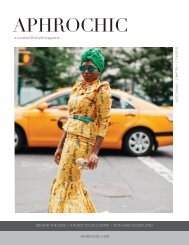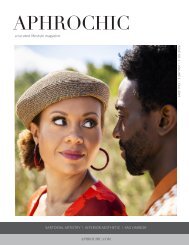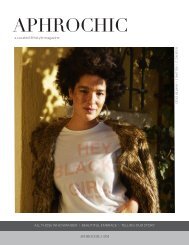AphroChic Magazine: Issue No. 4
In this issue, we sit down with artist, Malik Roberts, who relates the experience of creating one of the few African American artworks to sit permanently in the Vatican collection. Fashion designer, Prajjé Oscar John-Baptiste introduces his latest collection — an ode to Haiti, and its goddesses. We head to South Carolina to experience the Gullah-inspired music of Ranky Tanky. And in New York, we watch a new world being born with photographer and journalist, Naeem Douglass, who takes us inside the city’s Black Lives Matter protests, and economist Janelle Jones, who reminds us in these times that we are the economy. We are thrilled to share our cover with chef and musician, Lazarus Lynch. Inside, we talk with him about his cookbook, Son of a Southern Chef and his new album, I’m Gay. From a house tour in Brooklyn to a travel piece in Tobago, this issue takes you all over the Diaspora. And we see how of the concept of Diaspora was first introduced in a look back at how Pan-Africanism led the way to how we think of international Blackness today. It is a showcase of our culture, our creativity, our resilience, and our diversity, our demands for the present and our hopes for the future. Welcome to our summer issue.
In this issue, we sit down with artist, Malik Roberts, who relates the experience of creating one of the few African American artworks to sit permanently in the Vatican collection. Fashion designer, Prajjé Oscar John-Baptiste introduces his latest collection — an ode to Haiti, and its goddesses. We head to South Carolina to experience the Gullah-inspired music of Ranky Tanky. And in New York, we watch a new world being born with photographer and journalist, Naeem Douglass, who takes us inside the city’s Black Lives Matter protests, and economist Janelle Jones, who reminds us in these times that we are the economy.
We are thrilled to share our cover with chef and musician, Lazarus Lynch. Inside, we talk with him about his cookbook, Son of a Southern Chef and his new album, I’m Gay.
From a house tour in Brooklyn to a travel piece in Tobago, this issue takes you all over the Diaspora. And we see how of the concept of Diaspora was first introduced in a look back at how Pan-Africanism led the way to how we think of international Blackness today. It is a showcase of our culture, our creativity, our resilience, and our diversity, our demands for the present and our hopes for the future. Welcome to our summer issue.
You also want an ePaper? Increase the reach of your titles
YUMPU automatically turns print PDFs into web optimized ePapers that Google loves.
Reference<br />
near to diaspora, yet which never seemed to<br />
openly connect the phrase.<br />
The Politics of Pan-Africanism<br />
Despite the lengthy progress of forbears<br />
that Shepperson cited as constituting the long<br />
march to diaspora, the conceptual point of<br />
origin can be found earlier in his own work,<br />
specifically in his wrestling with the meaning<br />
and uses of the term, “Pan-Africanism.”<br />
In response to what he termed, “a most<br />
inadequate section on African Nationalism,”<br />
in the second book of the Tropical Africa series,<br />
by George H. T. Kimble, Shepperson wrote the<br />
concise but dense article, Pan-Africanism and<br />
“Pan-Africanism”: Some Historical <strong>No</strong>tes. In it,<br />
Shepperson made it clear that he took issue<br />
with Kimble’s simplistic description of Marcus<br />
Garvey’s political and economic philosophies<br />
as “the alloy of pan-Africanism … smelted into<br />
the ore of Ethiopianism.” In response, Shepperson<br />
clarified his position on the proper<br />
meaning and use of the term Pan-Africanism,<br />
dividing it into two separate terms, one with a<br />
capital “P,” and the other a lowercase “p”.<br />
The distinction between the two confines<br />
the overtly political “Pan-African” movement<br />
to the wide sphere of influence of W.E.B.<br />
Du Bois, whom he posits as the official center<br />
of the movement. Meanwhile, the lowercase<br />
“pan-Africanism,” consists of all of the more<br />
culturally-focused and less centralized<br />
movements that were also happening at the<br />
time — such as the Black Arts Movement —<br />
along with any political movements with no<br />
“organic relationship” to Du Bois’ Pan-Africanism.<br />
Shepperson placed Marcus Garvey,<br />
whose enmity with Du Bois was well established,<br />
somewhere between the two.<br />
While we are free to debate the efficiency<br />
of his approach to the problem (which also<br />
included the addition of a third term: “All-African”),<br />
Shepperson’s struggle to contain<br />
so many movements under a single term<br />
demonstrates the emerging limitations of the<br />
Pan-African concept. As Brent Hayes Edwards<br />
observed:<br />
On the one hand, Shepperson<br />
rereads the term precisely to make<br />
room for ideological difference and disjuncture<br />
in considering black cultural<br />
politics in an international sphere …<br />
In Shepperson’s view, it is crucial to be<br />
able to account for the transformative<br />
‘sea changes’ that Pan-African thought<br />
undergoes in a transnational circuit.<br />
Among the "sea changes" that Edwards<br />
mentions were the issues associated with<br />
communicating competing ideologies<br />
between languages. The many differences that<br />
separated the various forms of Pan-Africanism<br />
together with the scope of activity taking<br />
place on several continents, made the process<br />
of Internationalism (a term employed here to<br />
include both forms of Pan-Africanism) one of<br />
continual translation. This difficulty added to<br />
the already numerous gaps between groups —<br />
gaps that were widening in importance at the<br />
moment of Shepperson’s reconsideration of<br />
the term. His solution, Edwards reflects, was<br />
to work, “toward a revised or expanded notion<br />
of black international work that would be able<br />
to account for such unavoidable dynamics of<br />
difference, rather than either assuming a universally<br />
applicable definition of ‘Pan-African’<br />
or presupposing an exceptionalist version of<br />
New World ‘Pan-African’ activity.”<br />
Reconciling the needs of the quickly<br />
changing landscape with any of the constructions<br />
of Pan-Africanism available at the time<br />
quickly proved to be more than the concept<br />
could bear. Something new was needed. The<br />
process of becoming a conceptual diaspora<br />
therefore was not a simple one of connecting<br />
the story of African dispersal to that of<br />
Jewish dispersal as told in the Bible and other<br />
histories. Instead, the African Diaspora<br />
concept emerged as the result of a process of<br />
outgrowing the unilateral vision of a single,<br />
mono-centric Pan-African movement. Yet, the<br />
transition away from Pan-Africanism didn’t<br />
come about because the strategies and efforts<br />
that comprised its movements hadn’t worked,<br />
but because they had.<br />
The Birth of Many Nations<br />
The catalyst which would begin to<br />
render obsolete what the celebrated anthropologist<br />
St. Clair Drake called “traditional<br />
Pan-Africanism”, was the accomplishment<br />
of the political liberation that the movement<br />
had labored for so long to realize. As Drake<br />
framed it, “[T]he period of uncomplicated,<br />
united struggle to secure independence from<br />
the white oppressor ended for each colony as it<br />
became a nation.”<br />
With the gradual absence of a ubiquitous<br />
force of oppression came the crumbling of<br />
the amalgamated front that had been erected<br />
to resist it. Africa was no longer the centerpiece<br />
of an internationally-aligned struggle<br />
for independence. Divergent national identities<br />
emerged as political priorities diversified.<br />
New African and Caribbean nations turned to<br />
questions of self-governance, while those on<br />
the American continent devoted themselves to<br />
the fight for civil rights and equality at home.<br />
Meanwhile, in Africa, a series of armed<br />
coups led to what Drake termed “a parade to<br />
the seats of power of military men who had no<br />
allegiance to the kind of sentimental Pan-Africanism<br />
[that their predecessors espoused],<br />
and who were without any previous experience<br />
in dealing with West Indians and Afro-Americans.”<br />
Yet despite this political parting of ways,<br />
the sense of connection culturally, historically,<br />
if not politically, remained and demanded new<br />
modes of articulation.<br />
New words, that would embrace the<br />
legacy of Internationalism, support cultural<br />
pan-Africanism, and yet loosen the bonds of<br />
a Pan-African ideology based on a common<br />
political destiny that stratified even as it was<br />
being achieved. Shepperson’s nomination of<br />
diaspora filled that gap.<br />
It’s questionable whether Henry<br />
Sylvester Williams envisioned Pan-Africanism<br />
as a singular movement, or if he imagined the<br />
number of activities, groups, and leaders that<br />
would eventually be gathered under the term<br />
— or all that they would accomplish. That it<br />
was ultimately unable to contain the multitude<br />
of ideas that grew under its umbrella was<br />
perhaps the greatest mark of Pan-Africanism’s<br />
success.<br />
The vision of what Black Liberation<br />
was, what it would mean and how it could be<br />
achieved was never truly singular, even within<br />
a single organization. But there was a certain<br />
unity of direction that became difficult to<br />
maintain as African colonies became African<br />
nations, and the restricted yet somewhat<br />
generalized national identity of the “African<br />
Abroad” became specifically “Trinidadian,”<br />
“Jamaican,” “African American” and so on.<br />
The solidification of national identities<br />
and the necessary separation of political goals<br />
that attended it created a level of self-interest<br />
that was antithetical to the “Pan” element of<br />
“Pan-Africanism.”<br />
Diaspora, therefore makes a timely<br />
entrance into a conversation that was just<br />
beginning to turn from the politics of unity to<br />
a deeper exploration of the meanings of difference<br />
in the global Black community.<br />
What remains of Pan-Africanism today<br />
is largely culturally focused. Though it would<br />
be inaccurate to ever categorize Black cultural<br />
activity as apolitical, to the extent that any<br />
unified Pan-African movement could be said<br />
to exist today, it lacks much of the ability to<br />
influence policy that Du Bois and other leaders<br />
had at the height of their activity. Harris and<br />
Shepperson introduced diaspora as, undoubtedly,<br />
the more accurate description of<br />
the amalgam of African and Africa-descended<br />
cultures that cross the world today.<br />
However, there is still much that the<br />
focus and intensity of Pan-Africanism could<br />
teach to its far less politically-inclined<br />
successor.<br />
And as the strength and support behind<br />
the Movement for Black Lives and other<br />
groups continues to grow, inspiring protests<br />
across the world in response to the continued<br />
murder of Black people by police in America,<br />
the examples of Pan-Africanism’s chief<br />
leaders, strategists, and theorists may be<br />
becoming more relevant by the day. AC<br />
Marcus Garvey in Regalia, 1924. James VanDerZee. Copyright Donna Mussenden<br />
VanDerZee. All rights reserved. Photographs and Prints Division, Schomburg Centers for<br />
Research in Black Culture, The New York Public Library.<br />
The Ethiopian World Federation. Photographs and Prints Division, Schomburg Centers for<br />
Research in Black Culture, The New York Public Library.<br />
104 aphrochic issue four 105





